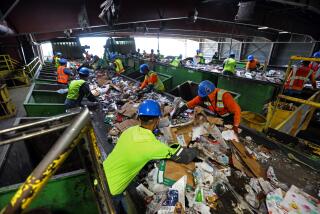Radials Go Radical in Their 2nd Life : Environment: One tire is tossed each year for every man, woman and child in the country, more than 250 million nationwide. By the end of the century, they all may be put to use.
- Share via
This country throws out enough tires each year to more than girdle the globe. That’s if they were set side by side upright. End to end, lying down, they’d be four deep around the Equator.
By the end of the century, they all may be put to use, the tire industry says. The Environmental Protection Agency agrees.
But there’s an if.
While states try to clear away anywhere from 1.5 billion to 3 billion tires already piled on roadsides, dumps and vacant lots, about 175 million a year are added to the heaps.
The EPA estimates that one tire is tossed each year for every man, woman and child in the country, more than 250 million nationwide.
There are markets for 75 million to 80 million. The rest are piled up, shredded and stockpiled, or--where it’s allowed--put into landfills.
Most states no longer let landfills take whole tires, because they can capture gas and squeeze up through the other garbage, even breaking through the heavy layer of clay used to cap the landfill.
A few states ban tires entirely. The rest require them to be cut or shredded. That saves space, since tires are large pockets of air encased in rubber. It also keeps water from pooling in the tires and creating a breeding place for mosquitoes, algae, germs and other undesirables.
Uses for recycled tires are as varied as imagination. Strips of rubber are cut into shoe soles or welded into mats for erosion control or temporary roads. Bales of compressed tires support a golf course and create its drainage system. Crumbled rubber becomes part of hockey pucks, roads, horse racing tracks, NCAA tracks.
Most go up in smoke, creating power for cement plants, paper factories and homes.
Anyone who’s ever been downwind of burning rubber will doubt the pollution claim.
“If you’re talking about a tire fire, there are an awful lot of pollutants that get released,” said Hope Pillsbury of the recycling section in the EPA’s office of solid waste in Washington. “But high-temperature incineration is a different story.
“Tires burn in the same ballpark as coal. If you’ve got high-sulfur coal, it probably burns dirtier than tires. Plus you’ve got a lot of pollution-control equipment.”
The prediction that all scrap tires could be recycled by the end of 1998 comes from John Serumgard, chairman of the Scrap Tire Management Council and vice president of its parent organization, the Rubber Manufacturing Assn.
But his equation depends on the federal law requiring states to use rubber mixed with asphalt on their roads.
If the law is enforced, up to 70 million tires a year could go into highways. But there’s no enforcement money in this year’s budget, and no telling when there will be.
Among other things, not everyone agrees that the rubber-asphalt mix is a good thing. Asphalt can be recycled. Rubber-asphalt, or RUMAC, cannot.
Still, Serumgard said, rubber recycling has come an incredible way in less than a decade, especially in the last few years.
“In 1985, the EPA estimated that less than 6% of all scrap tires were used in any positive way,” he said. “By 1990, it was 10.7%.”
Now, about one-third of all tires are recycled.
“We would estimate that probably 5 million are going into ground-rubber applications, probably another 5 million are going into civil-engineering applications,” Serumgard said. “The balance, about 70 million, are going into fuel uses.”
The growth of the industry can be tracked in the pages of Scrap Tire News, which Mary Sikora and her family first published eight years ago. The inaugural issue was four pages. It now runs 20 pages a month. January’s special issue comparing the laws of all 50 states took 36 pages.
The Scrap Tire Users Directory, also published by the Sikoras, has grown from 1,200 listings to 2,000 over three editions.
Which is not to say that tire recycling is a fail-safe business.
Kenny Stewart added $175,000 worth of shredders and conveyor belts to his Riverside Recycling plant after Louisiana decreed that every tire sale must include a $2 fee to pay for clearing away old tires.
He sold the business 15 months later. “We couldn’t compete with someone who is working out of the back of a pickup truck and throwing them out into a back alley or abandoned lot,” Stewart said.
About six months later, the woman who bought Stewart’s tire equipment called to tell him she was selling out too.
Louisiana has recycling rules but just proposed a new set in February because the current ones, approved in 1992, don’t work.
When new tires are sold, the seller takes in an extra $2. Half goes to the state Department of Environmental Quality to enforce the law. The other half is supposed to cover the cost of proper disposal.
Tire dealers take the lowest bid--often under $1--and the lowest bidder sometimes dumps tires, said Michael Vince, program manager for recycling in the DEQ’s solid waste division.
Many other states have similar laws, but none has been able to stop “tire jockeys” from dumping tires on vacant lots or roadsides.
“As far as I know, in the state of Connecticut, we are the only ones with a permit, yet there are beaucoup tire jockeys in Connecticut,” said Bruce Hayn, general manager at Oxford Tire Supply in Plainfield.
His company collects 100,000 tons of tires a year--about 13.75 million--from Connecticut and 11 surrounding states. About 20% are in good enough shape to sell for reuse or re-treading. The remaining 11 million are fuel for Oxford’s sister company, Exeter Energy Co.
“That’s 300 tons a day--approximately 30,000 tires a day, seven days a week,” Hayn said. “It works out to approximately enough electricity for 30,000 homes, or about one tire per day per home.”
Oxford Tire is paid about $1 for every car tire it collects, although large tires from front-end loaders and other heavy equipment fetch as much as $200.
Exeter’s plant produces 30 megawatts a day. It uses about 1.5 megawatts itself, and sells the rest to Northeast Utilities for 6 to 8 cents a kilowatt.
“The facility in Connecticut can utilize 10 million tires a year,” Serumgard said. “You say 10 million isn’t much compared to 250 million scrap tires. Let me tell you, 10 million is an awful lot of tires if you have to bring them to one particular spot.”
More to Read
Sign up for Essential California
The most important California stories and recommendations in your inbox every morning.
You may occasionally receive promotional content from the Los Angeles Times.













